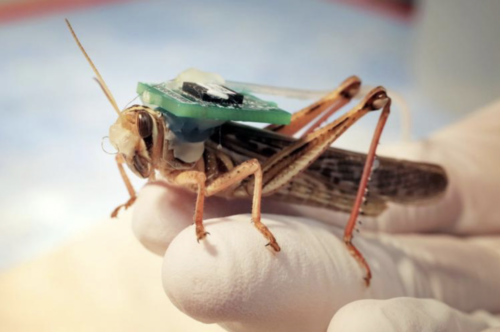Image Courtesy of Singamaneni laboratory.
As strange as it sounds, locusts may play an important role in uncovering the mysteries behind smell. For a long time, scientists studied locusts to achieve a better understanding of complex biological systems, ecology, and animal psychology without directly experimenting on humans. Locusts have a great sense of smell because they need it to survive in the wild, making them perfect candidates for olfactory research.
The sense of smell is an intricate physiological phenomenon that involves a sequence of complex neural pathways. In humans, smell starts when aromatic molecules stimulate olfactory receptors in our nose. These receptors then carry signals to the olfactory bulb, a structure in front of our brains. Finally, those signals are interpreted by the olfactory cortex, allowing for smell classification. As locusts have evolved, nature has optimized their sense of smell. But it turns out that their olfactory abilities can be expanded even further. A team of researchers led by Srikanth Singamaneni and Barani Raman at Washington University in St. Louis has engineered a new method to improve locusts’ senses of smell.
Their technique, known as nanoparticle neuromodulation, delivers tiny particles called nanoparticles to olfactory receptor neurons in the locusts’ brains. These nanoparticles are enclosed by fatty lipid membranes that only allow certain compounds to enter. The researchers made the nanoparticle shells porous enough that neurotransmitters—chemicals that allow for neuronal communication—can move in and out easily. When these nanoparticles bind to the olfactory receptors, they enhance odor detection and perception. These nanoparticles can be activated on demand to allow for the controlled release of neurotransmitters that bind to olfactory receptors.
The researchers tested two possible techniques to activate these nanoparticles. The first approach, called photothermal neuromodulation, uses heat from a laser to melt the exterior of the shell, releasing the neurotransmitters inside the nanoparticles in the process. The other approach, called chemo-neuromodulation, deposits a neurotransmitter called octopamine into the nanoparticle. “Chemo-neuromodulation promotes associative learning in insect brains, and therefore allows the locust to better categorize smells,” Singamaneni said. In their pilot studies, the researchers found that both neuromodulation techniques demonstrated significant improvements in odor discrimination and could be used to design nanoparticles to release olfactory receptor-binding chemicals that enhance locusts’ smell.
The applications of nanoparticle neuromodulation are not just limited to insects. Nanoparticle neuromodulation may allow scientists to better understand how smell works in humans without the risk associated with alternative approaches. “Past research revealing what we know of smell was performed using invasive techniques [that involved] planting electrodes into the brain that compromised the biological system,” Singamaneni said. Compared to electrodes, the nanoparticle-based approach is more versatile and flexible; thus, the researchers are confident that their technique can be used for new therapies. In the future, the nanoparticles might supply specific neural regions with the necessary chemicals to treat common neuropsychiatric disorders, like delivering dopamine to motor-controlling brain regions of patients with Parkinson’s disease. Ultimately, a solution to help insects smell better may be the first step in designing novel treatments for complex diseases.

